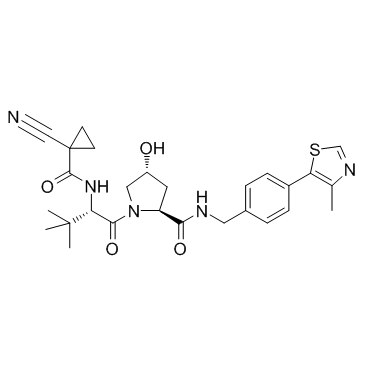| Cas No.: | 2097381-85-4 |
| Chemical Name: | (2S,4R)-1-((S)-2-(1-Cyanocyclopropanecarboxamido)-3,3-dimethylbutanoyl)-4-hydroxy-N-(4-(4-methylthiazol-5-yl)benzyl)pyrrolidine-2-carboxamide |
| Synonyms: | VH298;VH298 |
| SMILES: | C(C1(C(NC(C(C)(C)C)C(N2CC(O)CC2C(NCC2C=CC(C3SC=NC=3C)=CC=2)=O)=O)=O)CC1)#N |
| Formula: | C27H33N5O4S |
| M.Wt: | 523.652 |
| Purity: | >98% |
| Sotrage: | 2 years -20°C Powder, 2 weeks 4°C in DMSO, 6 months -80°C in DMSO |
| Publication: | [1]. Frost J, et al. Potent and selective chemical probe of hypoxic signalling downstream of HIF-α hydroxylation via VHL inhibition. Nat Commun. 2016 Nov 4;7:13312. |
| Description: | VH-298 is a highly potent inhibitor of the VHL:HIF-α interaction with a Kd value of 80 to 90 nM, used in PROTAC technology. |
| Target: | Kd: 80 to 90 nM (VHL:HIF-α)[1] |
| In Vitro: | VH-298 is a potent, cell permeable and non-toxic chemical probe that triggers the hypoxic response by blocking the VHL. VH-298 is a highly potent inhibitor of the VHL:HIF-α interaction with Kd values of 90 and 80 nM in isothermal titration calorimetry and competitive fluorescence polarization assay. VH-298 binds with VHL complex very fast and dissociates slowly. VH-298 at 50 μM concentration exhibits negligible off-target effects in vitro against more than 100 tested cellular kinases, GPCRs and ion channels. VH-298 is cell permeable and not toxic to cells. The measured permeability of VH-298 is found to be 19.4 nm s -1. VH-298 induces concentration- and time-dependent on-target specific accumulation of hydroxylated HIF-α in human cell lines, including HeLa cancer cells and renal cell carcinoma 4 (RCC4) cells. VH-298 increases mRNA levels of EPO by 2.5-fold in RCC4-HA-VHL, but not in VHL-null RCC4-HA, indicating that pharmacological inhibition of VHL is able to stimulate endogenous EPO synthesis. VH-298 proves as effective as hypoxia in raising PHD2 and HK2 protein levels, however in HFF the BNIP3 protein level increases more with VH-298 treatment than hypoxia treatment[1]. |
| Kinase Assay: | VH-298 is screened at 50 μM concentration against a panel of 50 kinases. The remaining kinase activity is recorded in the end of the assay. The data is reported as average % activity remaining of assay duplicates for each kinase tested[1]. |
| Cell Assay: | Death of CTLs is analyzed by staining with 4′,6-diamidino-2-phenylindole (DAPI). Cells are plated in 96-well plates at 1×106 and treated with VHL inhibitors (VH-298) and respective non-binding cis-analogues for 24 h. Cells are spun down and resuspended in HBSS containing DAPI to identify dead and dying populations[1]. |
| References: | [1]. Frost J, et al. Potent and selective chemical probe of hypoxic signalling downstream of HIF-α hydroxylation via VHL inhibition. Nat Commun. 2016 Nov 4;7:13312. |

 DC Chemicals' products qualify for U.S. tariff exemptions. We guarantee no price increases due to customs duties and maintain stable supply, continuing to deliver reliable research solutions to our American clients.
DC Chemicals' products qualify for U.S. tariff exemptions. We guarantee no price increases due to customs duties and maintain stable supply, continuing to deliver reliable research solutions to our American clients.





















